Energy is everything – Albert Einstein.
But is it? The current scenario regarding the relation between people and energy is, most of the time, purely economical. Although the production and consumption of energy are subjects that are present in the current discussions on environmental, geopolitical and economic issues, citizens in general are not aware of their impact and stake in these. In this scenario, cities are usually fulcrums of energy consumption, but, at the same time, the places where energy accessibility is taken for granted, which provokes a purely economic relation with the topic. The current understanding of the energy sector sees citizens as consumers of a commodity: energy. Thus, in order to set new possible relations between the citizens and the energy sector, it is crucial to start monitoring and rewarding citizens’ energy-related behavior. These ideas, thent led this project to understand and ressignify the relation of citizens with energy in the city through tracking, awareness and rewards policies.
UNDERSTANDING ENERGY
To better develop the project, the first step taken was to study the Spanish energy sector. Analyzing the stakeholders and its connections, two main flows were identified as key: the energy flow and the financial flow. The energy flow regards the physical aspect of electricity being transmitted from the generators up until the final consumer. One important aspect within this flow is that the energy generators have to deliver electricity directly to the grid – Red Electrica de España – not being able to detach the production of energy from the comprehensive electrical system and build off grid self sufficient systems. The financial flows, on the other hand, are related to how the electricity being produced is being traded and resseled. The generators can only trade energy inside the regulated market of energy of the Iberic peninsula – OMIE – and sell it to certified traders inside the same market. This certified trades, then, resell the energy to the final consumers.


Both of the analyzed flows show that there are big central nodes in the chain of relations between the stakeholders and many middle men in between the good and the final consumer. Another intrinsic characteristic of the sector in general is the blackboxing of the relations of energy towards the consumer, which most of the times only perceive all this chain of relations through energy bills. As a conclusion of this phase of the project, four goals were set to be achieved with the proposal, as shown in the image below, which could possibly be the drivers of new relations between citizens and energy.

ENERGY COMMUNITIES
Energy communities are a concept broadly explored by the European Union in the past years and its goal is to “organize collective and citizen-driven energy actions that will help pave the way for a clean energy transition, while moving citizens to the fore. They (…) make it easier to attract private investments in the clean energy transition¹”. This project saw the opportunity of using the energy community business model to achieve the goals set before. As shown in the diagram below, energy communities are a collective way of producing, selling and consuming energy. The relation of direct ownership with the means of production and the connection between the profit generated and the individual consumption of energy are the key factors to enhance new relations towards energy.
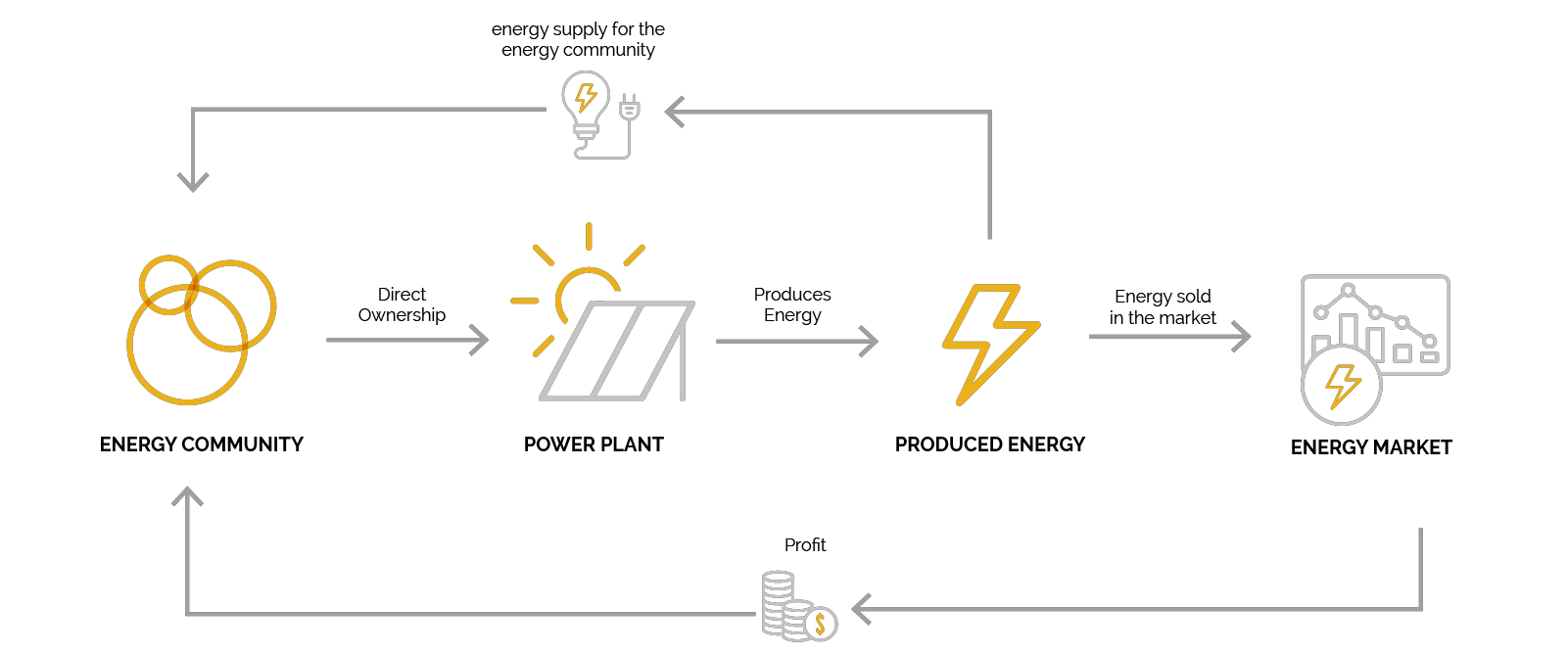
Comparing the current scenario and the energy community strategy, two concepts stand out. Firstly, users are not consumers anymore and secondly, many of the middle men transactions can be cut off. In general, the citizens that participate in energy communities, thus, are made responsible and aware of their energy consumption, being able to play an active role in their performance inside the system, while still having financial benefits and participating in the decision making process.

ENERGY CURVES
Setting the model of energy communities, the next step was to understand how, inside the legal framework of the Spanish scenario, would it be possible to make the demand and price curves of energy be used in favor of the better performance of the energy community. The main analysis performed for it was understanding the trends of the OMIE market², attempting to define the patterns of peak and valley hours of energy prices and consumption. This analysis was made considering the granularity of hours of the day, looking at the energy prices of one year. The main trend found to set the peak and valley hours is related to days within a week that show a clear pattern in between weekdays, Fridays, Saturdays and Sundays.
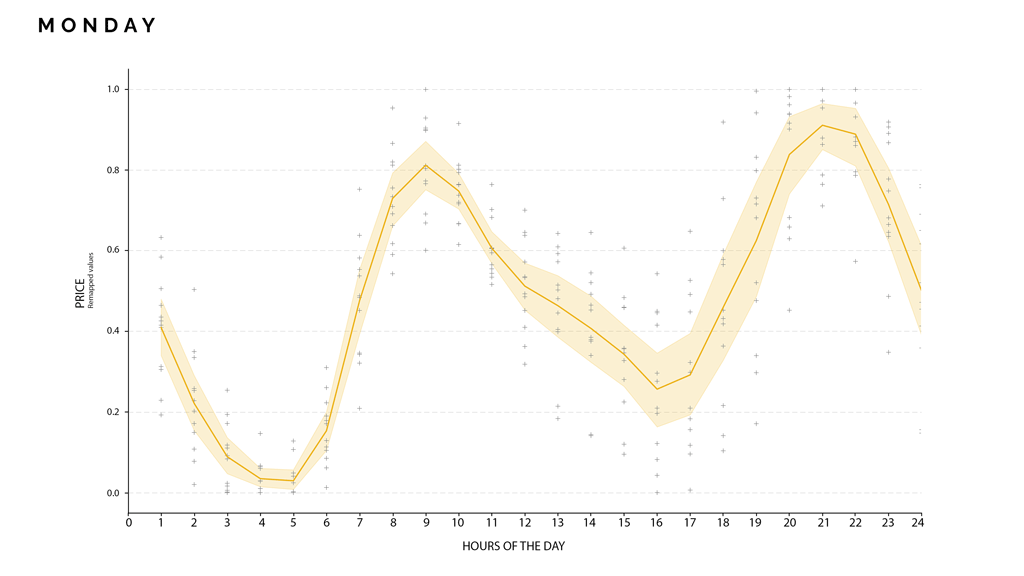
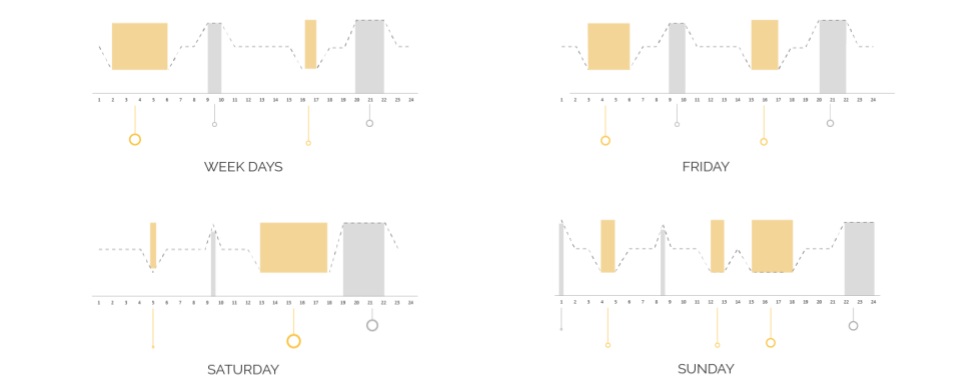
More details on how this analysis was performed can be found in this publication below:
ENERGY PLATFORM
The analysis performed so far led to the final step of the projects, a proposal for an Energy Platform inside the city of Barcelona. The energy platform proposed is based on the energy community model combined with the analysis performed for the energy market, resulting in an interactive interface based set of policies for enhancing the energy citizen concept.
Read More:
Energy Citizen is a concept being developed over the last years that “means that citizens actively participate in taking action towards climate neutrality. This can take many forms, from homeowners opting for renewable energy solutions or electric vehicles, to participation in energy communities or advocating for change on a global scale.
In order to understand the scale of the energy community proposed, the first step was to calculate what would be the supply and demand of energy needed to set a platform like this. The generation form of energy chosen for this feasibility study was solar energy, for the sake of exemplifying the energy community model and also because of the high potential and incentive of the solar energy production in Catalunya?. Regarding the production of solar energy, the study represented in the graphic below? shows that the highest feasibility of solar power plants are when those produce between 10 and 20MW of energy.

In order to scale this figure into physical aspects, the average consumption of a city block inside Barcelona was calculated. These calculations were made based on the dataset of energy efficiency certifications provided by the Region of Catalunya. ?

By comparing average consumption and the amount of energy to be produced, the ideal scale of an energy community was then set, being approximately nine Barcelona city blocks, meaning approximately 7500 people engaged, 25% discount on their energy bills and 10% of monthly profit inside the energy community.

Further on, the best place of application of the energy platform was the next question to answer. Considering the city of Barcelona and more specifically the Eixample district, three indicators were used to find a neighborhood that could welcome the energy platform. Considering high population density, low income and high energy consumption areas, the neighborhood of Sant Antoni came as a feasible geographic location to further develop strategies inside the energy platform.
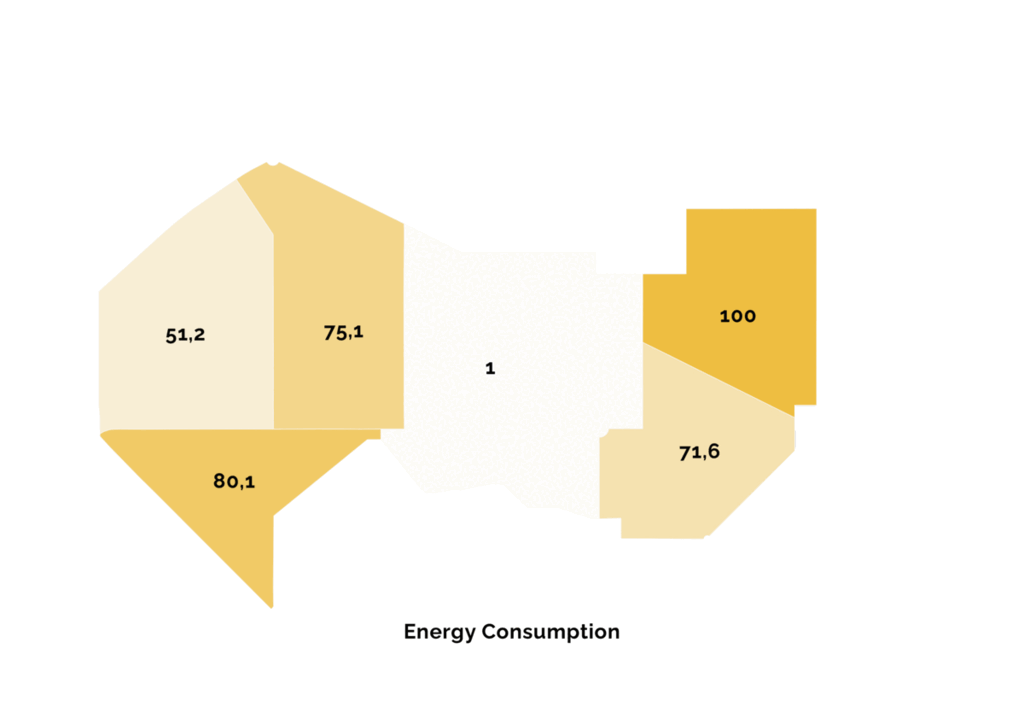
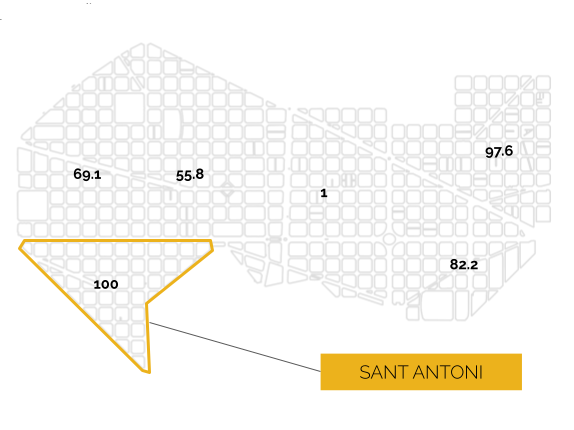
The neighborhood of Sant Antoni is part of the Barcelona superblock strategy? which is set to provide more public space for the community, especially by redesigning the streets with more pedestrian friendly landscapes. Considering the superblock strategy an expandable and replicable form of urban planning, this project understands that the proposition of the energy platform in such a scenario could add a new dimension to the superblock, binding the overall goals of increased public space with its availability and usage related to energy. At this phase of the project, we understand the energy and the public space are the two assets that should be combined. Represented by the municipality, the public space offers the physicality of the proposal, whereas the activation of it depending on energy usage and energy curves can be enhanced by the energy community, combining everything in the energy platform proposed.

The interface of the energy platform is personalized to each user type and divided into four main sections: ProActive, Efficiency, Community and Investment. Each of these sections represent a different set of strategies that the users inside the platform can undertake to increase their personal energy performance and, consequently, the overall balance of the energy platform. Choosing to interact and engage with the proposed strategies inside the platform, each user can be rated by an energy coefficient and be rewarded by it in different forms.
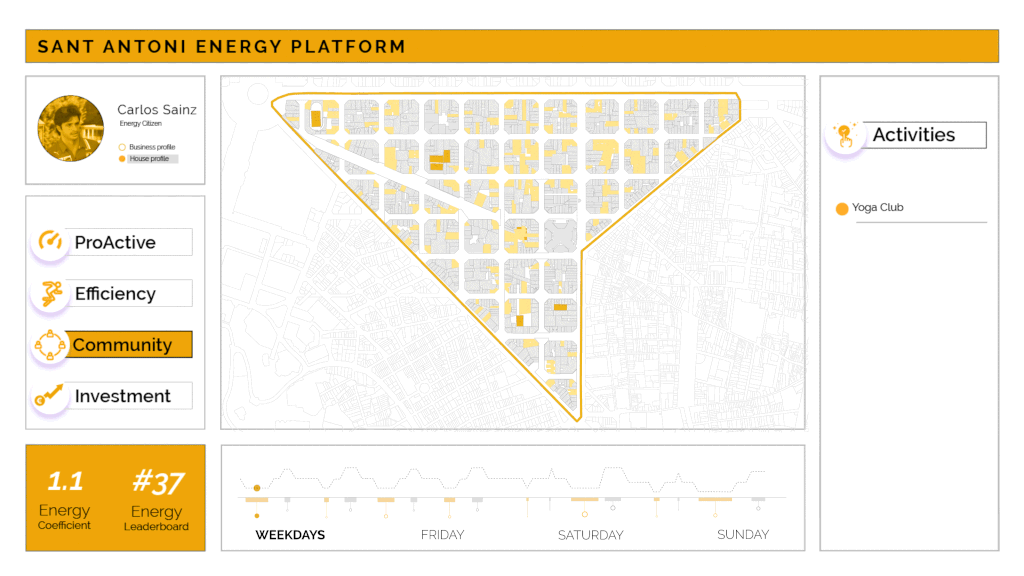
The ProActive strategy relates a set of actions that individuals, businesses, households and public spaces can undertake in order to consume energy in valley hours of energy prices, helping the overall balance between production and trade of energy inside the energy platform. Also, by tracking their energy consumption and its prices, users are more aware of their impact within the system.
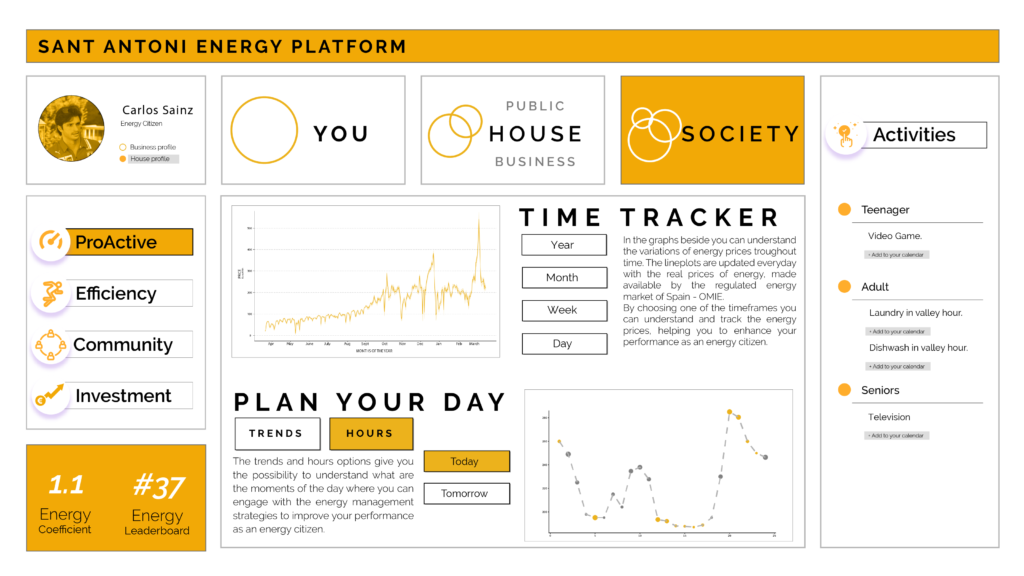
The Efficiency strategies are related to the efficiency of building and appliances inside business, households and public buildings. Subsidies for building refurbishments or for the acquisition of better rated appliances would be offered for those who would want to increase their energy efficiency.

When talking about community strategies, the platform sets two main actions to be engaged with: the promotion of low energy based activities in peak hours of energy prices to decrease the residential energy consumption and the promotion of high energy based activities in valley hours of energy prices. The combination of these two is the key strategy for the occupation of the public space by those engaged in the energy platform. Activities such as sports practices, office meetings, outdoor cinemas, faira and etc are seen as the drivers of the new possible relations between citizens, public space and energy. A set of possible scenarios are showcased in the images below.
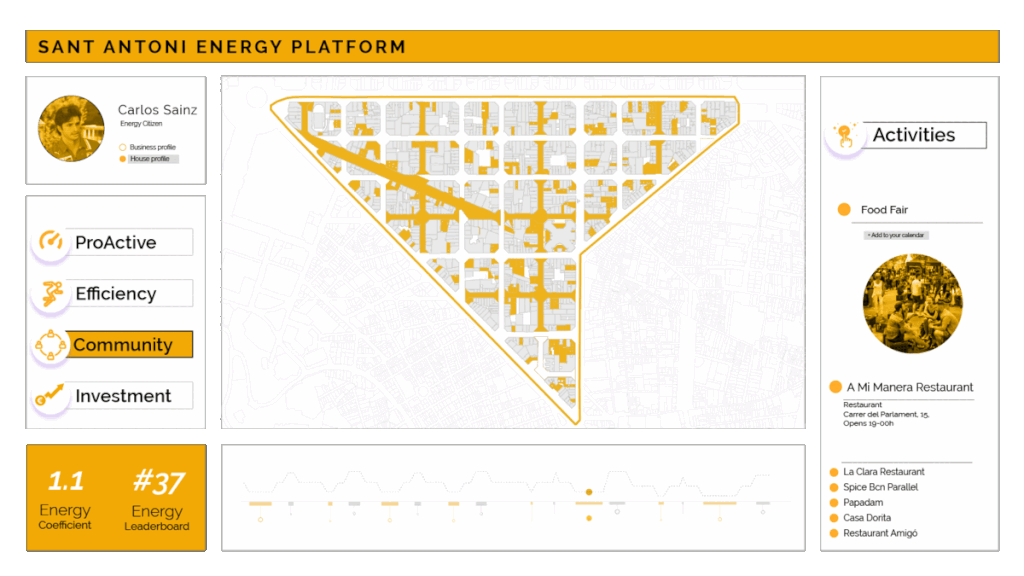
When it comes to financial strategies, the idea is that the energy platform could work not only as a new energy provider for its users, but also as an investment interface for those seeking to promote and invest in clean collective production of energy.

Finally, one next exploration of the energy platform would be the integration of business and the public space inside Sant Antoni. One possible approach is the tokenization of the energy performance of business owners and the possibility of trading it by the usage of public space by the private sector. Using blockchain technology to certify, issue and trade, business owners could be rewarded for their energy performance by the municipality granting them the use of public space.

The full research and feasibility study about this section of the project can be found on the link below:
References
1 – Energy Communities in the EU – European Comission for Energy Transition. Available at: https: //energy.ec.europa.eu/topics/markets-and-consumers/energy-communities_en
2 – OMIE Market. Available at: https: //omie.es
3 – Energy Citizens in the EU – Project Greta. Available at: https: //projectgreta.eu/energy-citizenship/
4 – Ayudas y Financiaciones – Generalitat de Catalunya. Available at: https: //icaen.gencat.cat/es/energia/ajuts/
5 – Is Bigger Best in Renewable Energy? – Insitute for Local Self-Reliance. Available at: https: //ilsr.org/report-is-bigger-best/
6 – ¿Qué es el Certificado Energético? – Selectra. Available at: https: //tarifasgasluz.com/faq/certificado-eficiencia-energetica
7 – Superblock Strategy – Ayuntamento de Barcelona. Available at: https: //ajuntament.barcelona.cat/superilles/en/
Energy Citizens is a project of IAAC, Institute for Advanced Architecture of Catalonia developed Master in City and Technology in 2021/2022
Students: L’Emir Karim Abilama, Maria Augusta Kroetz, Pushkar Runwal and Robert Yussef
Faculty: Luís Falcón and Iacopo Neri. Faculty Assistant: Tugdual Sarazin